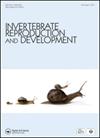Development of the soil-inhabiting stages of Ceratitis capitata infected with entomopathogenic nematodes: insights on survival
IF 0.8
4区 生物学
Q4 REPRODUCTIVE BIOLOGY
引用次数: 1
Abstract
ABSTRACT The Mediterranean fruit fly Ceratitis capitata (Wiedemann) (Diptera: Tephritidae) is a major pest that affects fruit production worldwide. This insect spends part of its life cycle in the soil, making it a target for entomopathogenic nematodes (EPNs). Laboratory assays were conducted to assess the development of the soil-inhabiting stages (third-instar larvae, prepupae, and pupae), in terms of survival, infected with the EPN strains Steinernema carpocapsae (Weiser) All, Steinernema riobrave Cabanillas, Poinar & Raulston ML29, Heterorhabditis bacteriophora (Poinar) HP88, and H. bacteriophora AS1. Treatment with the native strain (H. bacteriophora AS1) caused the highest mortality compared to the remaining exotic strains. Mortality of the third-instar larvae in the sand proportionally increased to the nematode density (infective juveniles per cm2). Of the tested stages, larvae were the most susceptible stage. Young pupae (1-day-old) were more susceptible to all nematode strains than older pupae (9-day-old). Development, in terms of survival, is a good criterion to evaluate the potential of EPNs to monitor C. capitata.感染昆虫病原线虫的头状Ceratis土壤栖息阶段的发育:对生存的见解
地中海果蝇角蝇(双翅目:角蝇科)是影响世界范围内水果生产的主要害虫。这种昆虫在土壤中度过其生命周期的一部分,使其成为昆虫病原线虫(epn)的目标。采用室内试验方法,对感染EPN菌株steinerma carpocapsae (Weiser) All、steinerma riobrave Cabanillas、Poinar & Raulston ML29、Heterorhabditis bacteriophora (Poinar) HP88和H. bacteriophora AS1后的土壤寄生期(3龄幼虫、预蛹和蛹)的存活率进行了评价。与剩余的外来菌株相比,用本地菌株(嗜菌杆菌AS1)处理造成的死亡率最高。沙中三龄幼虫的死亡率随线虫密度(每平方厘米感染幼虫数)的增加而成比例增加。其中,幼虫最易感染。幼蛹(1日龄)比老蛹(9日龄)对所有线虫品系更敏感。从存活的角度来看,发育是评价epn监测金针菇潜力的一个很好的标准。
本文章由计算机程序翻译,如有差异,请以英文原文为准。
求助全文
约1分钟内获得全文
求助全文
来源期刊
CiteScore
1.90
自引率
0.00%
发文量
21
审稿时长
>12 weeks
期刊介绍:
Invertebrate Reproduction & Development ( IRD) presents original research on the reproductive and developmental biology of the Invertebrata, both embryonic and postembryonic. IRD welcomes papers reporting significant results obtained using new techniques. Encouraged topic areas include: aquaculture, physiology, biochemistry, functional morphology, phylogeny, behavioural and regulatory mechanisms, including genetic, endocrine and molecular studies. Papers containing qualitative descriptions of reproductive cycles and gametogenesis will not be considered. IRD is published in association with the International Society of Invertebrate Reproduction and Development.

 求助内容:
求助内容: 应助结果提醒方式:
应助结果提醒方式:


